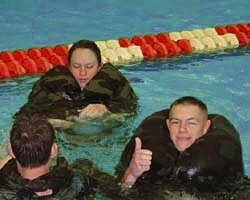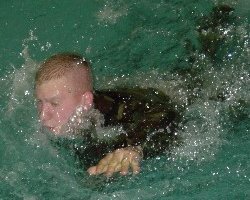Cadets' swimming and running performance
with and without a combat uniform
The aim was to examine whether a combat uniform (CU) influences the cadet's exercise performance in and out of the water.
Stylianos N Kounalakis 1, Ioannis Kostoulas 2, Konstantinos Havenetidis 2, Ioannis Giossos 2, Thrasivoulos Paxinos 2
Evelpidon Hellenic Army Academy, Faculty of Physical and Cultural Education, Vari, Greece.
Methods:
Fourteen male Army Officer cadets performed on 6 separate days:
- a maximal 400-m freestyle swimming trial
- a 4 x 50-m all-out freestyle swimming trial with 10 seconds rest in between
- a 50-m swim obstacle course with a CU (CUs)
- a 50-m swim obstacle course without a CU (NUs)
- a 1000-m track run with a CU (CU(R))
- a 1000-m track run without a CU (NUR)
Results:
The mean performance time was 44.3 +/- 3.1 s and 33.4 +/- 1.8 s in CUs and NUs trials, respectively.
Peak VO2 was similar in CUs, NUs, and 400 m (CUs: 59.1 +/- 1.1 ml x kg(-1) x min(-1), NUs: 57.3 +/- 2.1 ml kg(-1) x min(-1), 400 m: 58.2 +/- 1.6 ml x kg(-1) min(-1)).
[La] was higher in CUs than in NUs (CUs: 10.0 +/- 2.0 mmol x L(-1), NUs: 8.5 +/- 1.8 mmol x L(-1)), but it was lower in CUs and NUs than during the 400 m and 4 x 50 m.
SpO2 was lower (approximately 4.5%) in CUs than NUs. No differences were observed between running trials.
Conclusions:
The results suggest that the use of CU during swimming tasks induces high demands for energy and, thus, leads to a significant impairment of the swimming performance of the cadets. However, the influence of the CU seems to be less crucial during dry land running performance.
https://pubmed.ncbi.nlm.nih.gov/24479257/
PMID: 24479257 DOI: 10.3357/asem.3527.2014

